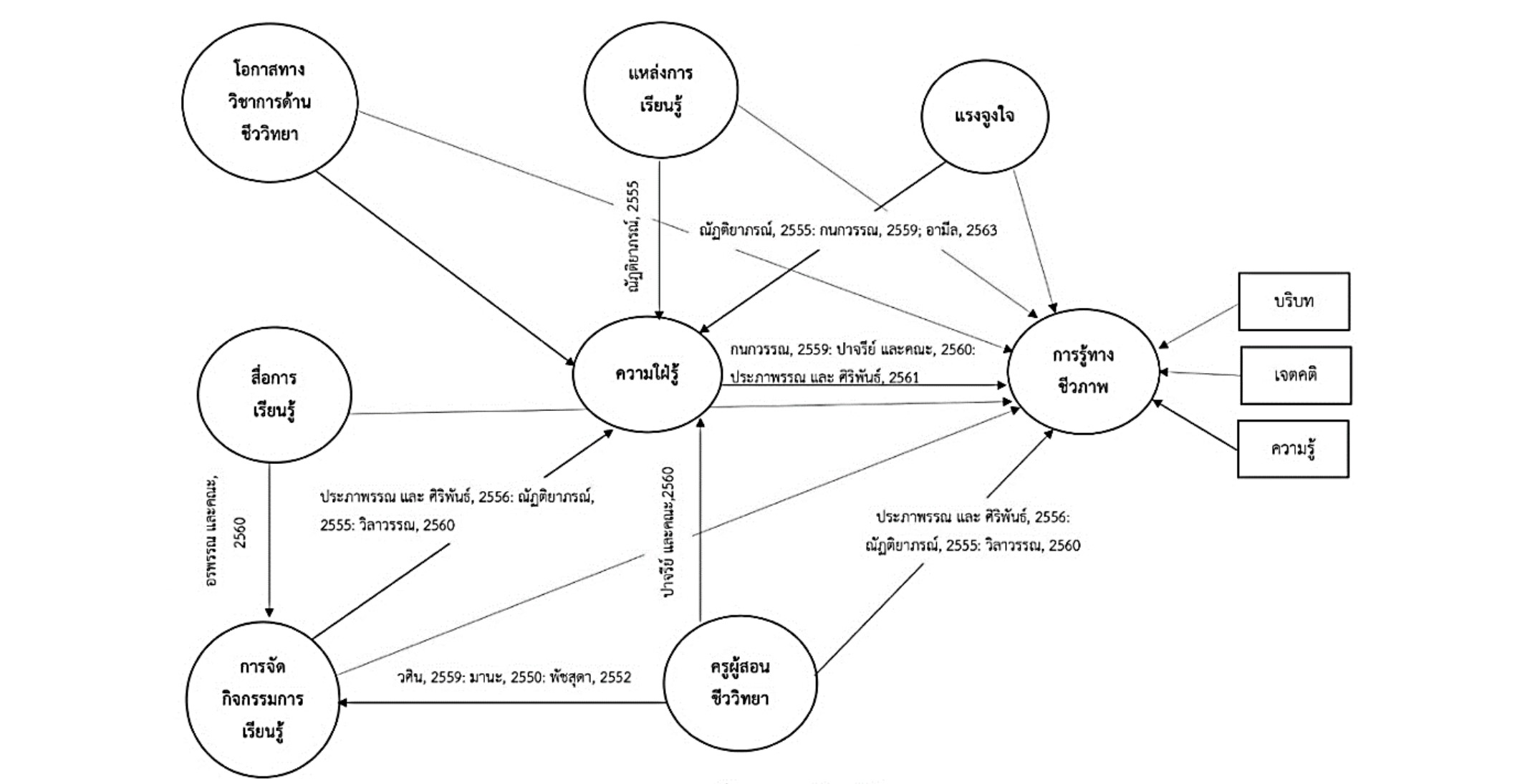Causal Influencing Biological Literacy of Students of Princess Chulabhorn Science High Schools in Thailand
DOI:
https://doi.org/10.14456/psruhss.2024.29Keywords:
Biological literacy, Students of princess chulabhorn science high schools in thailand, Causal factorAbstract
The objective of this research was to observe the causal factor influence the biological literacy of Princess Chulabhorn Science High Schools in Thailand. The population comprised of 1,580 students of Princess Chulabhorn Science High Schools in Mathayom 6 academic year 2564. According to the ratio of parameters, convenience sampling was selected by 275 students. The instruments used 12 questions including knowledge context and attitude. 7 aspects of questionnaire including motivation, curiosity, instructional media, edutainment, biology teacher, academic of biology, and source of learning. The data was statistically analyzed by the description statistics and analyzing the causal factors using Smart PLS program. The hypothesis testing results of the structural equation model from all 14 hypotheses showed that only 4 hypotheses were supported as followed: 1) academic of biology has a positive influence on curiosity, 2) biology teacher has a positive influence on edutainment, 3) instructional media has a positive influence on edutainment and 4) motivation has a positive influence on curiosity. The remaining of 10 hypotheses showed that the influence between the two latent variables is not statistically significant. This means that it cannot support the hypothesis set forth.
References
เจษฎาภรณ์ อ้นแก้ว, พัชราวลัย มีทรัพย์, และนิคม นาคอ้าย. (2557). ปัจจัยที่มีอิทธิพลต่อผลสัมฤทธิ์ทางการเรียนกลุ่มสาระการเรียนรู้วิทยาศาสตร์ของนักเรียนชั้นประถมศึกษาปีที่ 6 ในโรงเรียนสังกัดสำนักงานเขตพื้นที่การศึกษาประถมศึกษาจังหวัดพิษณุโลก: การวิเคราะห์พหุระดับโดยใช้โมเดลระดับลดหลั่นเชิงเส้น (HLM). วารสารมนุษยศาสตร์และสังคมศาสตร์ มหาวิทยาลัยราชภัฏพิบูลสงคราม, 8(1), 18-36.
ณัฏติยาภรณ์ หยกอุบล. (2555). ปัจจัยที่ส่งผลต่อผลสัมฤทธิ์ทางการเรียนวิชาวิทยาศาสตร์ของนักเรียนระดับชั้นประถมศึกษาปีที่ 6 โรงเรียนสาธิตสังกัดสำนักงานคณะกรรมการการอุดมศึกษา กระทรวงศึกษาธิการ. วารสารการศึกษาและพัฒนาสังคม, 8(1), 85-102.
ปาจรีย์ คุ้มสิงห์สันต์, แขก บุญมาทัน, และน้ำทิพย์ องอาจวาณิชย์. (2560). ปัจจัยที่ส่งผลต่อการจัดการเรียนรู้ทักษะกระบวนการทางวิทยาศาสตร์ ของครูที่สอนวิทยาศาสตร์ สังกัดสำนักงานเขตพื้นที่การศึกษาประถมศึกษาเพชรบูรณ์ เขต 3. ใน การประชุมวิชาการระดับชาติ มหาวิทยาลัยราชภัฏเพชรบูรณ์ ครั้งที่ 4 (น. 208-216). เพชรบูรณ์: สถาบันวิจัยและพัฒนา มหาวิทยาลัยราชภัฏเพชรบูรณ์.
พรทิพย์ ศิริภัทราชัย. (2556). ปัจจัยเชิงสาเหตุที่ส่งผลต่อผลสัมฤทธิ์ทางการเรียนวิทยาศาสตร์ของนักเรียนชั้นประถมศึกษาปีที่ 6 เขตวัฒนา กรุงเทพมหานคร. วารสารศรีนครินทรวิโรฒวิจัยและพัฒนา (สาขามนุษยศาสตร์และสังคมศาสตร์), 5, 80-91.
พีรพร แก้วแดง. (2554). ปัจจัยเชิงสาเหตุที่มีอิทธิพลต่อการรู้วิทยาศาสตร์ของนักเรียนชั้นมัธยมศึกษาปีที่ 3 สำนักงานเขตพื้นที่การศึกษาประถมศึกษา จังหวัดศรีสะเกษ (วิทยานิพนธ์ปริญญามหาบัณฑิต). มหาสารคาม: มหาวิทยาลัยมหาสารคาม.
มหาวิทยาลัยเชียงใหม่. (2563). คณะวิทย์ มช. เปิดเวทีแข่งขันชีววิทยาโอลิมปิกระดับชาติ ครั้งที่ 17. สืบค้น 14 มีนาคม 2564, จาก https://www.science.cmu.ac.th/prsci/news-detail.php?id=3874#.Yr2sAXZBzrd
วราพร บุญมี. (2563). สื่อการสอนกับการเรียนรู้ในศตวรรษที่ 21. วารสารการบริหารนิติบุคคลและนวัตกรรมท้องถิ่น, 7(9), 373-386.
สถาบันส่งเสริมการสอนวิทยาศาสตร์และเทคโนโลยี กระทรวงศึกษาธิการ. (2561). เทคโนโลยีทางดีเอ็นเอ. กรุงเทพฯ: โรงพิมพ์แห่งจุฬาลงกรณ์มหาวิทยาลัย.
สำนักงานคณะกรรมการการศึกษาขั้นพื้นฐาน กระทรวงศึกษาธิการ. (2560). ตัวชี้วัดและสาระการเรียนรู้แกนกลาง กลุ่มสาระการเรียนรู้วิทยาศาสตร์ (ฉบับปรับปรุง พ.ศ. 2560). สืบค้น 14 มีนาคม 2564, จาก http://physics.ipst.ac.th/wp-content/uploads/sites/2/2019/02/SciCurriculum_2560.pdf
สำนักบริหารงานความเป็นเลิศด้านวิทยาศาสตร์ศึกษา. (2562). แผนกลยุทธ์กลุ่มโรงเรียนวิทยาศาสตร์จุฬาภรณราชวิทยาลัย. สืบค้น 14 มีนาคม 2564, จาก https://www.pcccr.ac.th/filesAttach/OIT/O4/1.pdf
อามีล มาหามะ, อาฟีฟี ลาเต๊ะ, และแววฤดี แววทองรักษ์. (2564). การศึกษาเปรียบเทียบและการสร้างเกณฑ์ปกติการรู้วิทยาศาสตร์ของนักศึกษาวิชาชีพครูในพื้นที่สามจังหวัดชายแดนภาคใต้. วารสารมหาวิทยาลัยราชภัฏยะลา, 16(3), 287-296.
Bitler, M., Corcoran, S. P., Domina, T., & Penner, E. K. (2021). Teacher effects on student achievement and height: A cautionary tale. Journal of research on educational effectiveness, 14(4), 900-924.
Dawkins, R. (n.d.). How to Become a Biology Teacher. https://www.teacher.org/career/biology-teacher/
Hair, J. F., Black, W. C., Babin, B. J., & Anderson, R. E. (2010). Multivariate Data Analysis (7th ed.). Upper Saddle River, NJ: Prentice Hall.
Onel, A., & Durdukoca, S.F. (2019). Identifying the Predictive Power of Biological Literacy and Attitudes Toward Biology in Academic Achievement in High School Students. International Online Journal of Educational Sciences, 11(2), 214-228.
Ringle, C. M., Götz, O., Wetzels, M., & Wilson, B. (2009). On the use of formative measurement specifications in structural equation modeling: A Monte Carlo simulation study to compare covariance-based and partial least squares model estimation methodologies. METEOR Research Memoranda.
Suwono, H., Pratiwi, H., E., Susanto, H., & Susilo, H. (2017). Enhancement of Students’ Biological Literacy and Critical thinking of Biology Through Socio-Biological Case-Based Learning. Pendidikan IPA Indonesia, 6(2), 213-220.

Downloads
Published
How to Cite
Issue
Section
License
Copyright (c) 2024 Humanities and Social Sciences Journal of Pibulsongkram Rajabhat University

This work is licensed under a Creative Commons Attribution-NonCommercial-NoDerivatives 4.0 International License.
Any articles or comments appearing in the Journal of Humanities and Social Sciences, Rajabhat Phibulsongkram University, are the intellectual property of the authors, and do not necessarily reflect the views of the editorial board. Published articles are copyrighted by the Journal of Humanities and Social Sciences, Rajabhat Phibulsongkram University.








